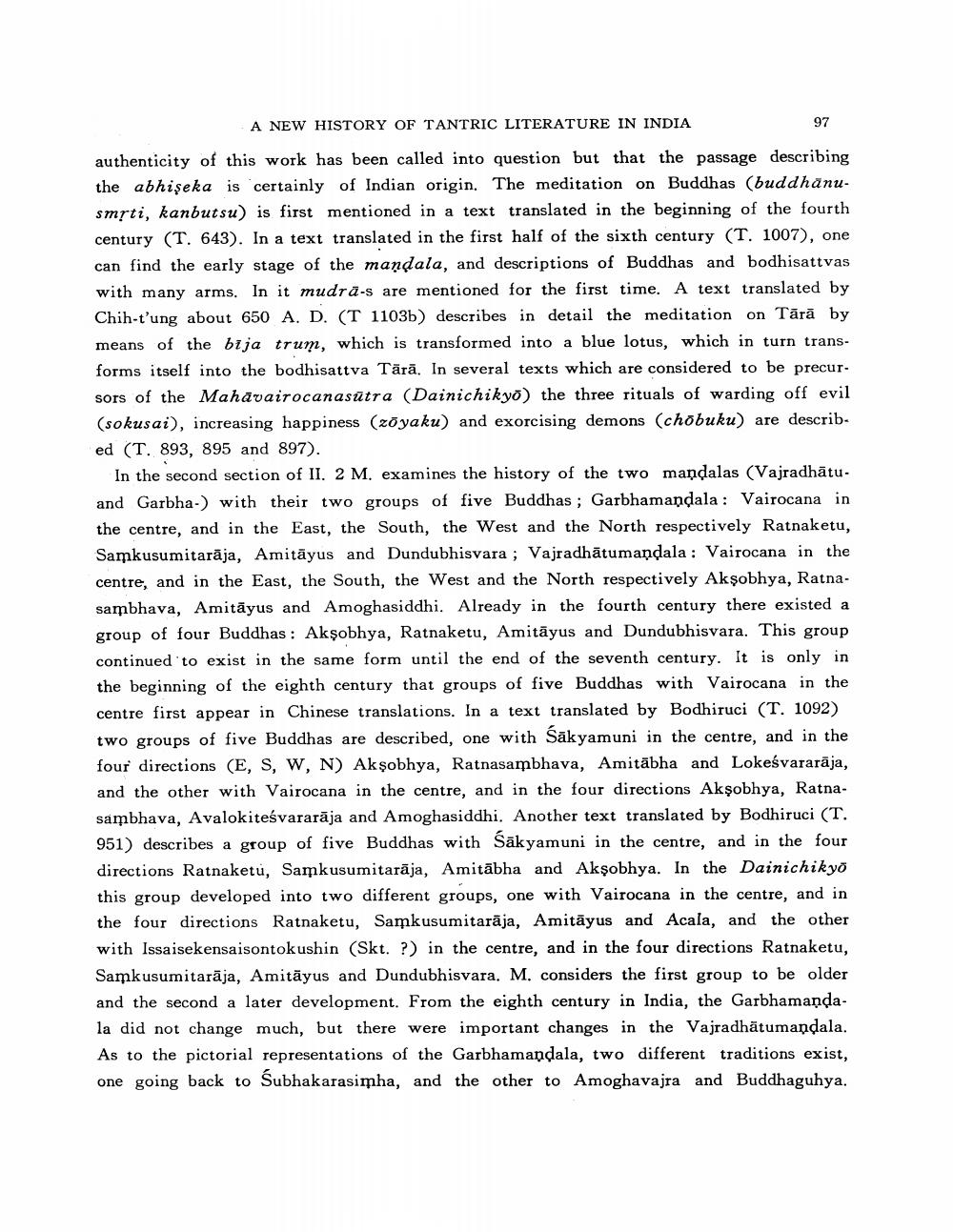Book Title: New History Of Tantric Lieterature In India Author(s): J W De Jong Publisher: J W De Jong View full book textPage 7
________________ A NEW HISTORY OF TANTRIC LITERATURE IN INDIA authenticity of this work has been called into question but that the passage describing the abhiseka is certainly of Indian origin. The meditation on Buddhas (buddhanusmộti, kanbutsu) is first mentioned in a text translated in the beginning of the fourth century (T. 643). In a text translated in the first half of the sixth century (T. 1007), one can find the early stage of the mandala, and descriptions of Buddhas and bodhisattvas with many arms. In it mudra-s are mentioned for the first time. A text translated by Chih-t'ung about 650 A. D. (T 1103b) describes in detail the meditation on Tārā by means of the bija trum, which is transformed into a blue lotus, which in turn transforms itself into the bodhisattva Tārā. In several texts which are considered to be precursors of the Mahavairocanasūtra (Dainichikyo) the three rituals of warding off evil (sokusai), increasing happiness (zo yaku) and exorcising demons (chobuku) are described (T. 893, 895 and 897). In the second section of II. 2 M. examines the history of the two mandalas (Vajradhātuand Garbha-) with their two groups of five Buddhas ; Garbhamandala : Vairocana in the centre, and in the East, the South, the West and the North respectively Ratnaketu, Samkusumitarāja, Amitāyus and Dundubhisvara; Vajradhātumandala : Vairocana in the centre, and in the East, the South, the West and the North respectively Akşobhya, Ratnasambhava, Amitäyus and Amoghasiddhi. Already in the fourth century there existed a group of four Buddhas : Akşobhya, Ratnaketu, Amitāyus and Dundubhisvara. This group continued to exist in the same form until the end of the seventh century. It is only in the beginning of the eighth century that groups of five Buddhas with Vairocana in the centre first appear in Chinese translations. In a text translated by Bodhiruci (T. 1092) two groups of five Buddhas are described, one with Sākyamuni in the centre, and in the four directions (E, S, W, N) Akşobhya, Ratnasambhava, Amitabha and Lokeśvararāja, and the other with Vairocana in the centre, and in the four directions Akşobhya, Ratnasambhava, Avalokitesvararāja and Amoghasiddhi. Another text translated by Bodhiruci (T. 951) describes a group of five Buddhas with Sākyamuni in the centre, and in the four directions Ratnaketu, Samkusumitarāja, Amitābha and Akşobhya. In the Dainichikyo this group developed into two different groups, one with Vairocana in the centre, and in the four directions Ratnaketu, Samkusumitarāja, Amitāyus and Acala, and the other with Issaisekensaisontokushin (Skt. ?) in the centre, and in the four directions Ratnaketu, Samkusumitarāja, Amitāyus and Dundubhisvara. M. considers the first group to be older and the second a later development. From the eighth century in India, the Garbhamandala did not change much, but there were important changes in the Vajradhātumandala. As to the pictorial representations of the Garbhamandala, two different traditions exist, one going back to Subhakarasimha, and the other to Amoghavajra and Buddhaguhya.Page Navigation
1 ... 5 6 7 8 9 10 11 12 13 14 15 16 17 18 19 20 21 22 23
